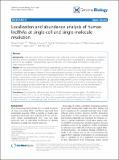| dc.contributor.author | Cabili, Moran N | |
| dc.contributor.author | Dunagin, Margaret C | |
| dc.contributor.author | McClanahan, Patrick D | |
| dc.contributor.author | Biaesch, Andrew | |
| dc.contributor.author | Padovan-Merhar, Olivia | |
| dc.contributor.author | Regev, Aviv | |
| dc.contributor.author | Rinn, John L | |
| dc.contributor.author | Raj, Arjun | |
| dc.date.accessioned | 2016-12-09T14:57:35Z | |
| dc.date.available | 2016-12-09T14:57:35Z | |
| dc.date.issued | 2015-01 | |
| dc.date.submitted | 2014-10 | |
| dc.identifier.issn | 1465-6906 | |
| dc.identifier.uri | http://hdl.handle.net/1721.1/105770 | |
| dc.description.abstract | Background: Long non-coding RNAs (lncRNAs) have been implicated in diverse biological processes. In contrast to extensive genomic annotation of lncRNA transcripts, far fewer have been characterized for subcellular localization and cell-to-cell variability. Addressing this requires systematic, direct visualization of lncRNAs in single cells at single-molecule resolution.
Results: We use single-molecule RNA-FISH to systematically quantify and categorize the subcellular localization patterns of a representative set of 61 lncRNAs in three different cell types. Our survey yields high-resolution
quantification and stringent validation of the number and spatial positions of these lncRNA, with an mRNA set for comparison. Using this highly quantitative image-based dataset, we observe a variety of subcellular localization patterns, ranging from bright sub-nuclear foci to almost exclusively cytoplasmic localization. We also find that the low abundance of lncRNAs observed from cell population measurements cannot be explained by high expression in a small subset of ‘jackpot’ cells. Additionally, nuclear lncRNA foci dissolve during mitosis and become widely dispersed, suggesting these lncRNAs are not mitotic bookmarking factors. Moreover, we see that divergently transcribed lncRNAs do not always correlate with their cognate mRNA, nor do they have a characteristic localization pattern.
Conclusions: Our systematic, high-resolution survey of lncRNA localization reveals aspects of lncRNAs that are similar to mRNAs, such as cell-to-cell variability, but also several distinct properties. These characteristics may correspond to particular functional roles. Our study also provides a quantitative description of lncRNAs at the single-cell level and a universally applicable framework for future study and validation of lncRNAs. | en_US |
| dc.description.sponsorship | National Institutes of Health (U.S.). Pioneer Award | en_US |
| dc.description.sponsorship | Klarman Cell Observatory | en_US |
| dc.description.sponsorship | Center for Cell Circuits (P50 HG006193-01) | en_US |
| dc.description.sponsorship | Howard Hughes Medical Institute | en_US |
| dc.language.iso | en_US | |
| dc.publisher | Biomed Central Ltd. | en_US |
| dc.relation.isversionof | http://dx.doi.org/10.1186/s13059-015-0586-4 | en_US |
| dc.rights | Creative Commons Attribution 4.0 International License | en_US |
| dc.rights.uri | http://creativecommons.org/licenses/by/4.0/ | en_US |
| dc.source | BMC | en_US |
| dc.title | Localization and abundance analysis of human lncRNAs at single-cell and single-molecule resolution | en_US |
| dc.type | Article | en_US |
| dc.identifier.citation | Cabili, Moran N et al. “Localization and Abundance Analysis of Human lncRNAs at Single-Cell and Single-Molecule Resolution.” Genome Biology 16.1 (2015): 20. | en_US |
| dc.contributor.department | Massachusetts Institute of Technology. Department of Biology | en_US |
| dc.contributor.mitauthor | Regev, Aviv | |
| dc.relation.journal | Genome Biology | en_US |
| dc.eprint.version | Final published version | en_US |
| dc.type.uri | http://purl.org/eprint/type/JournalArticle | en_US |
| eprint.status | http://purl.org/eprint/status/PeerReviewed | en_US |
| dspace.orderedauthors | Cabili, Moran N; Dunagin, Margaret C; McClanahan, Patrick D; Biaesch, Andrew; Padovan-Merhar, Olivia; Regev, Aviv; Rinn, John L; Raj, Arjun | en_US |
| dspace.embargo.terms | N | en_US |
| dc.identifier.orcid | https://orcid.org/0000-0001-8567-2049 | |
| mit.license | PUBLISHER_CC | en_US |
